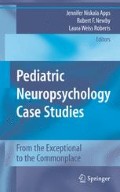Abstract
Victoria was unusually quiet as an infant, seldom cooing or babbling. She spoke her first words a bit late at 18 months and began combining two to three words at age 2½ years. Her speech was very difficult to understand, but her parents assumed that her pronunciation would improve with age. An evaluation conducted by the local school district to determine school readiness indicated that Victoria had profound delays in articulation and phonological skills. She was subsequently enrolled in a phonology program at age 4 years. The program was minimally effective; her speech remained 80–85% unintelligible to everyone except her immediate family. In kindergarten, Victoria struggled to learn letter sounds and seemed to have more difficulty than her peers with following directions and answering questions. Her classmates understood very little of what she said and constantly teased her because she sounded “like a baby.” Both Victoria's parents and teacher noticed that she seemed sad and withdrawn.
Victoria's speech was often monotone and she had a tendency to stress the wrong syllables of words. Her parents began to wonder about a hearing impairment. Shortly after her sixth birthday, Victoria was evaluated by an audiologist. Her peripheral and middle ear function were normal in both ears. However, further testing suggested that she had difficulty discriminating the subtle differences between sounds in words, especially in noisy environments. She also had difficulty understanding the meaning of words and phrases. Victoria was subsequently diagnosed with (central) auditory processing disorder ((C)APD). The audiologist provided detailed recommendations including the use of an FM system and referred Victoria to the school Individualized Education Program (IEP) team for an evaluation. The IEP team concluded that Victoria met eligibility criteria to receive special education services under the speech and language impairment classification. She began using an FM system and received pull-out speech and language therapy during the fourth quarter of her kindergarten year.
Access this chapter
Tax calculation will be finalised at checkout
Purchases are for personal use only
Preview
Unable to display preview. Download preview PDF.
References
Resources for Clinicians
American Speech—Language—Hearing Association. (2005). (Central) auditory processing disorders (Technical report). Available at http://www.asha.org/members/deskref-journls/deskref/default.
American Speech—Language–Hearing Association. (2005). (Central) auditory processing disorders — The role of the audiologist (Position statement). Available at http://www.asha.org/ members/deskref-journals/deskref/default.
Bellis, T. J. (2003). Assessment and management of central auditory processing disorders in the educational setting: From science to practice (2nd ed.). Clifton Park, NY: Delmar Learning.
Katz, J., & Tillery, K. L. (2005). Can central auditory processing tests resist supramodal influences? American Journal of Audiology, 14, 124–127.
Masters, M., Stecker, N., & Katz, J. (1998). Central auditory processing disorders: Mostly management. Boston: Allyn and Bacon.
Parthasarathy, T. K. (Ed.). (2006). An introduction to auditory processing disorders in children. Mahwah, NJ: Lawrence Erlbaum Associates.
Richards, G. J. (2001). The source for processing disorders. East Moline, IL: LinguiSystems.
Rosenberg, G. (2002). Classroom acoustics and personal FM technology in management of auditory processing disorders. Seminars in Hearing, 23(4), 309–318.
Resources for Families
American Academy of Audiology. 11730 Plaza America Drive, Suite 3000, Reston, VA 20190. Toll Free: (800) 222-2336 at www.audiology.org
American Speech—Language–Hearing Association. 10801 Rockville Pike, Rockville, MD 20852. Toll free: (800) 638-8244 at www.asha.org
National Institute of Deafness and Other Communication Disorders at www.nidcd.nih.gov/health/voice/auditory
NICHCY, National Dissemination Center for Children with Disabilities at www.nichcy.org
Author information
Authors and Affiliations
Editor information
Editors and Affiliations
Rights and permissions
Copyright information
© 2010 Springer Science+Business Media, LLC
About this chapter
Cite this chapter
Cox, L.R. (2010). A Little of This, A Little of That: (Central) Auditory Processing Disorder. In: Apps, J.N., Newby, R.F., Roberts, L.W. (eds) Pediatric Neuropsychology Case Studies. Springer, New York, NY. https://doi.org/10.1007/978-0-387-78965-1_30
Download citation
DOI: https://doi.org/10.1007/978-0-387-78965-1_30
Publisher Name: Springer, New York, NY
Print ISBN: 978-1-4419-6080-1
Online ISBN: 978-0-387-78965-1
eBook Packages: Behavioral ScienceBehavioral Science and Psychology (R0)

